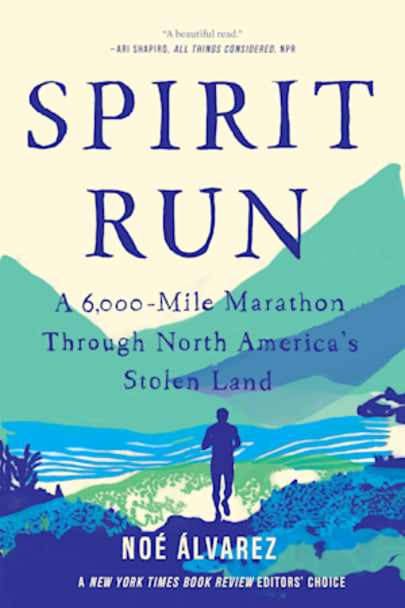In this New York Times Book Review Editors’ Choice, the son of working-class Mexican immigrants flees a life of labor in fruit-packing plants to run in a Native American marathon from Canada to Guatemala in this “stunning memoir that moves to the rhythm of feet, labor, and the many landscapes of the Americas” (Catriona Menzies-Pike, author of The Long Run).Growing up in Yakima, Washington, Noé … up in Yakima, Washington, Noé Álvarez worked at an apple–packing plant alongside his mother, who “slouched over a conveyor belt of fruit, shoulder to shoulder with mothers conditioned to believe this was all they could do with their lives.” A university scholarship offered escape, but as a first–generation Latino college–goer, Álvarez struggled to fit in.
At nineteen, he learned about a Native American/First Nations movement called the Peace and Dignity Journeys, epic marathons meant to renew cultural connections across North America. He dropped out of school and joined a group of Dené, Secwépemc, Gitxsan, Dakelh, Apache, Tohono O’odham, Seri, Purépecha, and Maya runners, all fleeing difficult beginnings. Telling their stories alongside his own, Álvarez writes about a four–month–long journey from Canada to Guatemala that pushed him to his limits. He writes not only of overcoming hunger, thirst, and fear—dangers included stone–throwing motorists and a mountain lion—but also of asserting Indigenous and working–class humanity in a capitalist society where oil extraction, deforestation, and substance abuse wreck communities.
Running through mountains, deserts, and cities, and through the Mexican territory his parents left behind, Álvarez forges a new relationship with the land, and with the act of running, carrying with him the knowledge of his parents’ migration, and—against all odds in a society that exploits his body and rejects his spirit—the dream of a liberated future.
“This book is not like any other out there. You will see this country in a fresh way, and you might see aspects of your own soul. A beautiful run.” —Luís Alberto Urrea, author of The House of Broken Angels
“When the son of two Mexican immigrants hears about the Peace and Dignity Journeys—‘epic marathons meant to renew cultural connections across North America’—he’s compelled enough to drop out of college and sign up for one. Spirit Run is Noé Álvarez’s account of the four months he spends trekking from Canada to Guatemala alongside Native Americans representing nine tribes, all of whom are seeking brighter futures through running, self–exploration, and renewed relationships with the land they’ve traversed.” —Runner’s World, Best New Running Books of 2020
“An anthem to the landscape that holds our identities and traumas, and its profound power to heal them.” —Francisco Cantú, author of The Line Becomes a River
more



Noe Alvarez takes us through his journey of self-discovery and recognition of his past. He joins a 6,000 mile run with the groupPeace and Dignity part of the Native American/ First Nations Movement .The writer shares with us that it is the Runners obligation to their elders to embrace the way of the warrior and show their respect for the land we are all connected to.The race illustrates to us even with all our imperfections we are still part of a whole something larger than ourselves that needs to be respected .When the author moves to Boston to explore life from different aspects other than Yakima,Washington he finds himself observing several workers enjoying their ride home on the train and notices how it is the small daily routines of life that make it so enjoyable.The author in the end tells us tomorrow is another run ! How right he is !
This memoir is about the authors life, and also what it is like being the son of working class Mexican immigrants, in a town in Washington state, and of his search to find out who he really is and what he stands for in this world.
His parents have had a hard life in the orchards and apple packing plants, that took everything out of them. I think a bit differently now when I bite into an apple that was so easy to acquire, knowing what it is like for the many workers in those packing plants. The author worked beside his mother at the plant while in high school and would always run to rid himself of the stress and frustration of his situation.
After high school Noe was lucky to have gotten a full scholarship to a university, and was excited about the prospect of getting an education and being able to help people in similar situations as his parents. Once at the school he just couldn’t settle his mind and then one day, he heard a talk by an organizer of a Native American/First Nations movement called the Peace and Dignity Journeys, a race that starts in Alaska through the Americas, to Panama. A journey of Native runners who want to connect with the earth, their spirituality and to find out about other Native Americans beliefs along the journey.
As the run starts and the runners head south, picking up runners in different locations, Noe encounters many different personalities, who have all had many hardships. Some with strong personalities, who did not always follow the rules or were not always as nice as they could have been to fellow runners, it was a hard run with many leg injuries along the way. The author made it to just over the Guatemalan Border, having run through Mexico, which had been his main goal, as he wanted to be able to connect to his parents native land.
He went back to education after leaving the race.
Beautifully written, he is a talented author.
I would like to thank NetGalley and Catapult for allowing me to read this book.